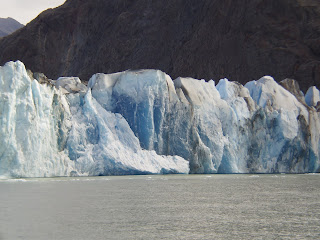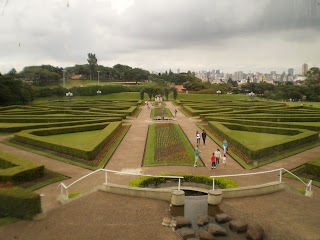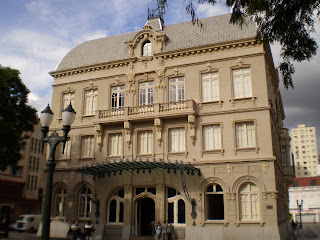This post covers our first leg in Buenos Aires, the second being in about 7-10 days when we return from Patagonia.
We travelled in style from Puerto Iguazu to Buenos Aires, opting for the more luxurious 'super cama' bus, complete with blankets, dinner, breakfast, drinks and even wifi (which didn't actually work).
We arrived in Buenos Aires on Friday morning, just in time for the commencement of the weekend in one of South America's notorious party cities. Beyond this, my knowledge of things to do in Buenos Aires was fairly limited. In many respects, I considered it a city that was famous for being famous. Thankfully I was wrong as there is plenty to do and see, and the city is actually the centre of a very interesting yet controversial history.
We were staying in San Telmo which is one of the older areas of the city, and conveniently located for exploring. With much of the first day gone after the overnight bus, check-in etc, the afternoon was spent walking around San Telmo which has plenty of small markets and cafes to pass the time. As we were now in the heart of Argentina, a mammoth steak was at the top of our list for dinner that night. We succeeded, finding a 400g steak with rice and fries for only AR25 (approx AU8) just 6 doors away. This placed us in good stead for the night to come.
Like Spain, Argentina, and especially Buenos Aires has a very late culture, with many eateries open till after midnight, and bars and clubs not really filling up until after 2. We kept this in mind as we set off to Cocoliche, an underground techno club just 8 blocks away. The only signs of life in the deserted street was a stocky bald man leaning against a building. When we enquired about our pre-arranged guestlist, we were asked 'what gueslist?'. After he concluded we were alright to enter, we realized quickly that that was by no means a purpose built club, rather a cafe/diner (we think) that had been converted. The upstairs had been converted to a bar area with the downstairs basement serving as the dancefloor area. By 3am the basement was full. We were the only gringo's in the club which was a touch daunting, but at the same time what we were after - a club that the locals go to. No photos unfortunately, but they wouldn't do much good anyway as it was the music and atmosphere of Cocoliche that made it great, not the aesthetics (or lack thereof) of the venue.
The next day, we headed over to Palermo to check out some of the shopping on offer. The area about 8 blocks from Plaza Italia is known as the hot-spot of Buenos Aires housing numerous fashion boutiques (comparable maybe to Greville Street?) and on Saturdays is also home to an arts and crafts market. Although the afternoon proved generally unsuccessful from a purchasing perspective, it served as an enjoyable afternoon and triggered Sam's memory for a good steakhouse she had visited the week prior. Mental note added.

That night we rounded up some crew from the hostel and headed for Pacha. This is the Buenos Aires installment of the worldwide superclub also seen in Ibiza, London etc and actually looks strikingly similar to the Ibiza establishment. The night would host USA DJ Christopher Lawrence, our motive for attending. Furthermore, Nick managed to pull some strings and organise guestlist for the evening. Things looked good. We arrived shortly after 2am in true Buenos Aires style to find the car park gates locked with a mob of people around it. Beyond this, a lengthy line had formed at the actual club entry. We didn't really think much of this, deeming it normal practice until the 4am lockout drew closer. Apparently Pacha was waiting for a government inspection or something and hence, the lockout. Whatever. At 3.30am we pulled the pin and headed over to CroBar with a local we befriended outside Pacha. CroBar is a purpose built techno superclub and was absolutely rammed when we arrived (uncomfortably so). Jesper Dahlback was the headliner for the night, of whom, we missed most of his set. Again, I didn't take a camera so no photos.
The next afternoon we awoke just in time for some local cuisine (McDonalds) to erase the indulgences of the night before, and jump on our transfer to watch Boca Juniors v Tigre. After being burnt by South American football before (Refer: Rio de Janeiro post), this was their second attempt to show us what they had. Thankfully they redeemed themselves. We sat in the safety of the gringo area towards the Tigre end of the pitch. There are a few adjectives that come to mind when describing the atmosphere but the photos and videos I think speak for themselves. Despite the Boca reputation, Tigre got up 3-0, the highlight being the second goal from a wide cross and diving header past the keeper. The victory meant Tigre supporters were locked in the ground for 45 minutes after the whistle as Boca fans left the neighbourhood. Next weekend is Boca Juniors v River Plate which we will unfortunately miss. Some local sources have told us tickets can reach up to AR1100. Ouch! We will hopefully be able to make it to a River Plate game the following week when prices/sanity return to normal.




I managed to drag myself out of bed before 11am the next day and took advantage of a free walking tour (Google: BA Free Tour - good tip). They offer two tours per day and at the end you can tip the guide whatever you feel necessary. Our tour was to focus on the convoluted political history of Argentina and took us down Avenida de Mayo and through the Centro area, highlighting the various buildings and monuments that depict this history. I wont elaborate on everything that was said, but its an interesting story thats worth a skim over wikipedia if you have the time. 3 hours well spent in my opinion.
[PHOTOS PENDING]
Following a quick lunch stop we went to see Eva Peron's grave - apparently a must-see. To be honest my knowledge of Evita is limited pretty much to...well nothing, so I can't say this experience was overly profound for me. That said, I'm sure it's the opposite for many that visit, as the volume of flowers etc at her grave are a testiment. Here's a photo for your viewing pleasure.
[PHOTOS PENDING]
Monday night meant it was time for La Bomba, a live and energetic drum show in a fairly obscure warehouse/plaza thing for the bargain price of AR20! We arrived late to find the queue stretching down the block and around the corner. Thankfully it moved quickly and we were in within 20 minutes. The place was packed and it was hard to move around, even to get a drink or go to the bathroom. The 2 hour show was worth it though, with the crowd really getting into the show.
A 7.00am flight the next morning to El Calafate meant an early night. Nick opted to ignore this and stayed up till 4am. Dragging an unconscious Nick out of his bed is not how envisaged the morning. Crisis averted - we made the flight!



















































